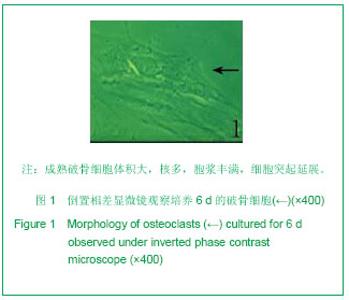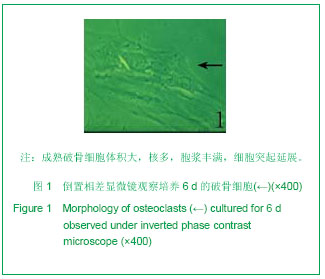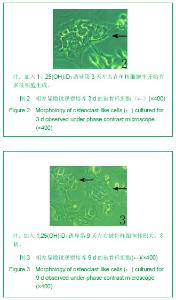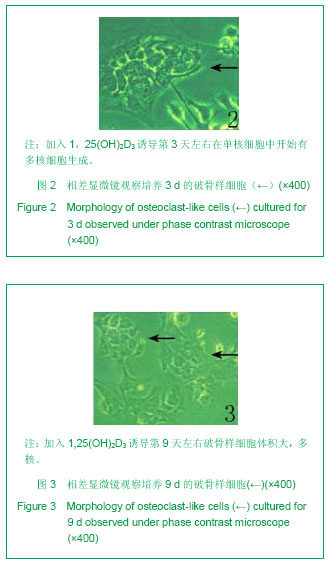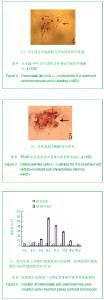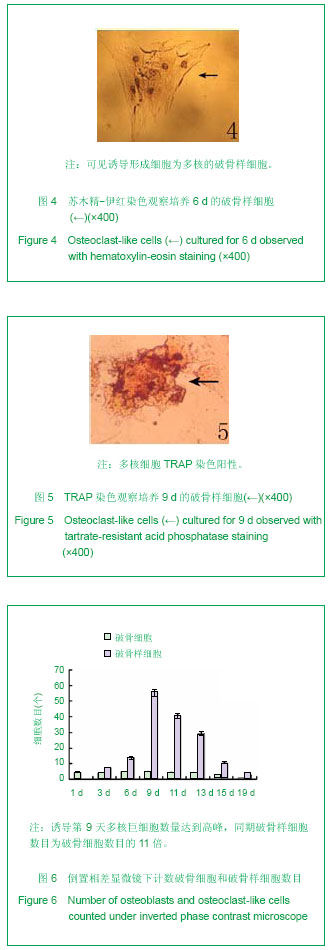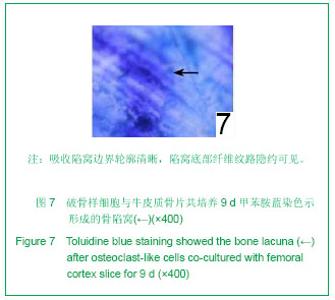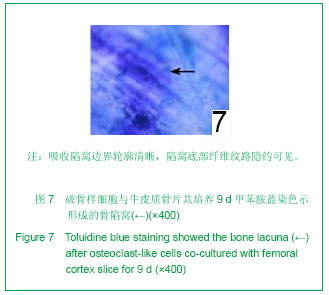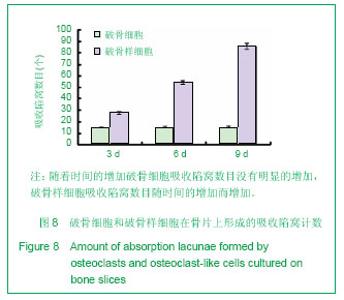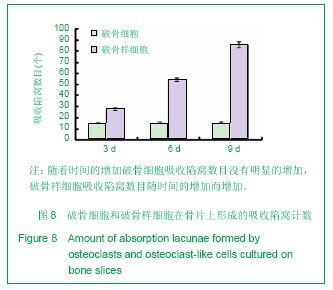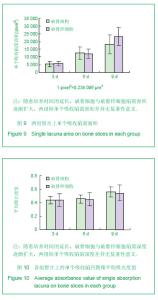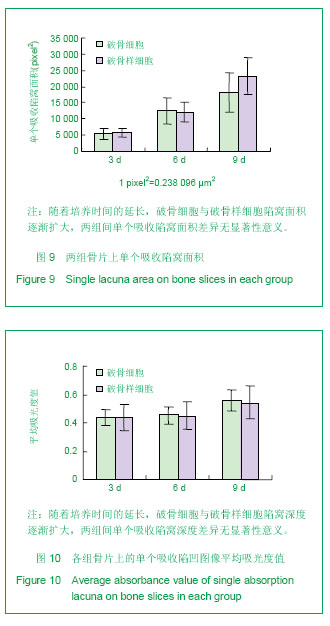| [1] Chambers TJ, Magnus CJ. Calcitonin alters behaviour of isolated osteoclasts. J Pathol. 1982;136(1):27-39.[2] Wang ZD,Yan N, Li WH,et al. Zhongguo Zuzhi Gongcheng Yanjiu yu Linchuang Kangfu. 2007;11 (19) :3698-3700.王正东,颜南,李文海,等.新生鼠股骨破骨细胞存在位置的确定及其噬骨能力验证[J].中国组织工程研究与临床康复,2007,11 (19) :3698-3700.[3] Testa NG, Allen TD, Lajtha LG,et al. Generation of osteoclasts in vitro. J Cell Sci. 1981;47:127-137.[4] Balani D, Aeberli D, Hofstetter W,et al. Interleukin-17A stimulates granulocyte-macrophage colony-stimulating factor release by murine osteoblasts in the presence of 1,25-dihydroxyvitamin D(3) and inhibits murine osteoclast development in vitro. Arthritis Rheum. 2013;65(2):436-446.[5] Tohmonda T, Yoda M, Mizuochi H,et al. The IRE1α-XBP1 pathway positively regulates parathyroid hormone (PTH)/PTH-related peptide receptor expression and is involved in pth-induced osteoclastogenesis. J Biol Chem. 2013;288(3):1691-1695. [6] Yan N,Wang ZD,Jin Y,et al. Zhongguo Zuzhi Gongcheng Yanjiu yu Linchuang Kangfu. 2008;12 (20) : 3818-3821.颜南,王正东,金韵,等.异丙肾上腺素对大鼠骨髓单核细胞向破骨细胞转化的影响[J]. 中国组织工程研究与临床康复,2008,12 (20):3818-3821.[7] Garcia-Palacios V, Chung HY, Choi SJ,et al. Eosinophil chemotactic factor-L (ECF-L) enhances osteoclast formation by increasing in osteoclast precursors expression of LFA-1 and ICAM-1. Bone. 2007;40(2):316-322. [8] Cai LM,Wang ZD,Yan N. Zhongguo Zuzhi Gongcheng Yanjiu yu Linchuang Kangfu. 2007;11 (28) : 5485-5487.柴立民,王正东,颜南.不同体积分数血清对培养原代破骨细胞噬骨能力的影响[J].中国组织工程研究与临床康复,2007,11 (28) : 5485-5487.[9] Wang ZD,Bai SL,Fan J. Jiepouxue Zazhi. 2008;31(2): 148-150.王正东,柏树令,范军. 1, 25二羟基胆钙化醇诱导大鼠骨髓单核细胞向破骨细胞转化的机制[J].解剖学杂志,2008,31(2): 148-150.[10] Gao JJ,Jin WF,Wang HF. Shanghai Yike Daxue Xuebao. 1998;25(1):71-73.高建军,金慰芳,王洪复. 骨片吸收陷窝光镜计数法定量测定破骨细胞功能[J].上海医科大学学报,1998,25(1):71-73.[11] Asai M, Lee JW, Itakura Y,et al. Effects of veraguensin and galgravin on osteoclast differentiation and function. Cytotechnology. 2012;64(3):315-322.[12] de Moraes M, de Matos FR, de Souza LB,et al. Immunoexpression of RANK, RANKL, OPG, VEGF, and vWF in radicular and dentigerous cysts. J Oral Pathol Med. 2012. [Epub ahead of print][13] Giganti MG, Liuni F, Celi M,et al. Changes in serum levels of TNF-alpha, IL-6, OPG, RANKL and their correlation with radiographic and clinical assessment in fragility fractures and high energy fractures. J Biol Regul Homeost Agents. 2012; 26(4):671-680.[14] Lacey DL, Boyle WJ, Simonet WS,et al. Bench to bedside: elucidation of the OPG-RANK-RANKL pathway and the development of denosumab. Nat Rev Drug Discov. 2012; 11(5):401-419. [15] Hanada R, Leibbrandt A, Hanada T,et al. Central control of fever and female body temperature by RANKL/RANK. Nature. 2009;462(7272):505-509.[16] Wade-Gueye NM, Boudiffa M, Vanden-Bossche A,et al. Absence of bone sialoprotein (BSP) impairs primary bone formation and resorption: the marrow ablation model under PTH challenge. Bone. 2012;50(5):1064-1073.[17] Kitazawa R, Mori K, Yamaguchi A,et al. Modulation of mouse RANKL gene expression by Runx2 and vitamin D3. J Cell Biochem. 2008;105(5):1289-1297. [18] Nerenz RD, Martowicz ML, Pike JW. An enhancer 20 kilobases upstream of the human receptor activator of nuclear factor-kappaB ligand gene mediates dominant activation by 1,25-dihydroxyvitamin D3. Mol Endocrinol. 2008;22(5): 1044-1056.[19] Yamashita T, Takahashi N, Udagawa N. New roles of osteoblasts involved in osteoclast differentiation. World J Orthop. 2012;3(11):175-181.[20] Dorotheou D, Gkantidis N, Karamolegkou M,et al. Tooth eruption: altered gene expression in the dental follicle of patients with cleidocranial dysplasia. Orthod Craniofac Res. 2013;16(1):20-27.[21] Wang BL,Liang H,Zheng F,et al. Shengli Xuebao. 2007;59(2): 169-174.王宝利,梁晖,郑纺,等.重组可溶性核因子κB受体活化因子体外抑制甲状旁腺激素诱导的破骨细胞生成[J]. 生理学报,2007, 59(2):169-174.[22] Xu DR,Yu XQ,Fang BQ. Zhonghua Shenzhangbing Zazhi. 2005 ;21(4):186-190.许多荣,余学清,方荸荠.甲状旁腺激素在体外对破骨细胞分化及骨重吸收能力的影响[J].中华肾脏病杂志,2005 ,21(4):186-190.[23] Wang XM,Yu SF,Yang ZP. Beijing Daxue Xuebao:Yixueban. 2000;32(4):358-361.王晓敏,于世凤,杨宗萍.白细胞介素-4对破骨细胞的分化作用[J].北京大学学报:医学版,2000,32(4):358-361. [24] Zhang R. Shijiazhuang:Hebei Medical University. 2011.张睿. M-CSF、RANKL和1,25-(OH)2D3对破骨细胞形成分化影响的比较研究[D].石家庄:河北医科大学,2011.[25] Zhang K,Chen XL,Wang DC,et al. Zhongguo Guzhi Shusong Zazhi. 2006;12(6): 561-565.张鲲,陈晓亮,王德春,等.两种方法培养大鼠破骨细胞的比较研究[J].中国骨质疏松杂志,2006,12(6): 561-565. |
